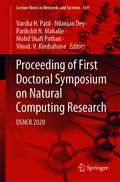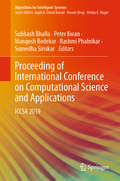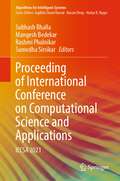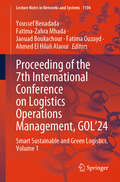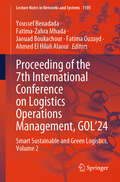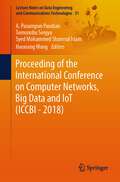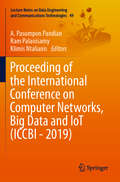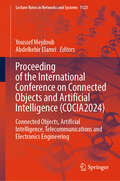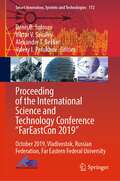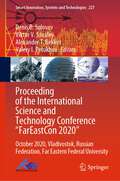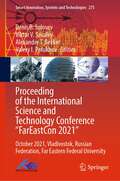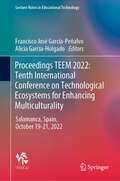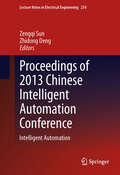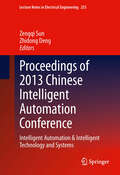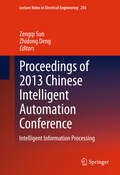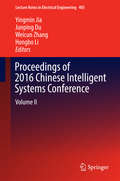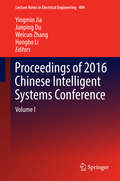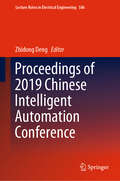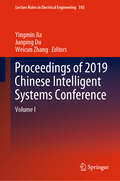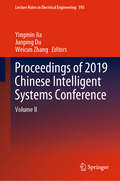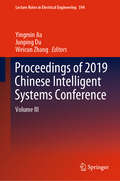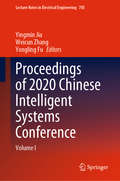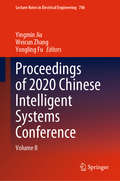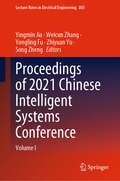- Table View
- List View
Proceeding of First Doctoral Symposium on Natural Computing Research: DSNCR 2020 (Lecture Notes in Networks and Systems #169)
by Nilanjan Dey Parikshit N. Mahalle Varsha H. Patil Mohd Shafi Pathan Vinod. V. KimbahuneThe book is a collection of papers presented at First Doctoral Symposium on Natural Computing Research (DSNCR 2020), held during 8 August 2020 in Pune, India. The book covers different topics of applied and natural computing methods having applications in physical sciences and engineering. The book focuses on computer vision and applications, soft computing, security for Internet of Things, security in heterogeneous networks, signal processing, intelligent transportation system, VLSI design and embedded systems, privacy and confidentiality, big data and cloud computing, bioinformatics and systems biology, remote healthcare, software security, mobile and pervasive computing, biometrics-based authentication, natural language processing, analysis and verification techniques, large scale networking, distributed systems, digital forensics, and human–computer interaction.
Proceeding of International Conference on Computational Science and Applications: ICCSA 2019 (Algorithms for Intelligent Systems)
by Subhash Bhalla Peter Kwan Mangesh Bedekar Rashmi Phalnikar Sumedha SirsikarThe book consists of high-quality papers presented at the International Conference on Computational Science and Applications (ICCSA 2019), held at Maharashtra Institute of Technology World Peace University, Pune, India, from 7 to 9 August 2019. It covers the latest innovations and developments in information and communication technology, discussing topics such as soft computing and intelligent systems, web of sensor networks, drone operating systems, web of sensor networks, wearable smart sensors, automated guided vehicles and many more.
Proceeding of International Conference on Computational Science and Applications: ICCSA 2021 (Algorithms for Intelligent Systems)
by Subhash Bhalla Mangesh Bedekar Rashmi Phalnikar Sumedha SirsikarThis book consists of high-quality papers presented at the International Conference on Computational Science and Applications (ICCSA 2021), held at Maharashtra Institute of Technology World Peace University, Pune, India, from 10 – 11 December 2021. It covers the latest innovations and developments in information and communication technology, discussing topics such as algorithms, data structures and applications; wireless and mobile networks; computer networks and communications; natural language processing and information theory; cryptography and information security.
Proceeding of the 24th International Conference on Industrial Engineering and Engineering Management 2018
by Chen-Fu Chien Runliang Dou George Q. HuangThis book records the new research findings and development in the field of industrial engineering, and it will serve as the guidebook for the potential development in industrial engineering and smart manufacturing. It gathers the accepted papers from the 24th International conference on Industrial Engineering and Engineering Management held at Central South University of Forestry and Technology in Changsha during May 19-20, 2018. The aim of this conference was to provide a high-level international forum for experts, scholars and entrepreneurs at home and abroad to present the recent advances, new techniques and application, to promote discussion and interaction among academics, researchers and professionals to promote the developments and applications of the related theories and technologies in universities and enterprises, and to establish business or research relations to find global partners for future collaboration in the field of Industrial Engineering. It addresses diverse themes in smart manufacturing, artificial intelligence, ergonomics, simulation and modeling, quality and reliability, logistics engineering, data mining and other related fields. This timely book summarizes and promotes the latest achievements in the field of industrial engineering and related fields over the past year, proposing prospects and vision for the further development.
Proceeding of the 7th International Conference on Logistics Operations Management, GOL'24: Smart Sustainable and Green Logistics, Volume 1 (Lecture Notes in Networks and Systems #1104)
by Youssef Benadada Fatima-Zahra Mhada Jaouad Boukachour Fatima Ouzayd Ahmed El Hilali AlaouiThis book presents the advances in the concept, model, method, and tools for the global supply chain management. The conference took place in Marrakesh from May 2 to May 4, 2024. The 7th edition of this conference focused on Smart Sustainable and Green Logistics. The papers included in the book's proceedings cover various themes, such as: . Metaheuristics for industry 4.0 . Multi-agent systems for solving combinatorial optimization problems . Sustainability in supply chain management: a paradigm for global transformation . Sustainable and agile supply chain management . Sustainable and smart management of water resources: innovative optimization . Artificial intelligence and emerging technologies: advancements and applications . Artificial intelligence techniques and statistical modeling for mobility and urban logistics planning . Smart and green process in transport and logistics . Viability of logistics networks, structural dynamics and recovery strategy—low certainty context . Modeling, simulation and optimization . Planning and scheduling . Decision support systems . Risk management . Project management . Information systems integration . Supply chain design and control . Models and algorithms for electric mobility
Proceeding of the 7th International Conference on Logistics Operations Management, GOL'24: Smart Sustainable and Green Logistics, Volume 2 (Lecture Notes in Networks and Systems #1105)
by Youssef Benadada Fatima-Zahra Mhada Jaouad Boukachour Fatima Ouzayd Ahmed El Hilali AlaouiThis book presents the advances in the concept, model, method, and tools for the global supply chain management. The conference took place in Marrakesh from May 2 to May 4, 2024. The 7th edition of this conference focused on Smart Sustainable and Green Logistics. The papers included in the book's proceedings cover various themes, such as: . Metaheuristics for industry 4.0 . Multi-agent systems for solving combinatorial optimization problems . Sustainability in supply chain management: a paradigm for global transformation . Sustainable and agile supply chain management . Sustainable and smart management of water resources: innovative optimization . Artificial intelligence and emerging technologies: advancements and applications . Artificial intelligence techniques and statistical modeling for mobility and urban logistics planning . Smart and green process in transport and logistics . Viability of logistics networks, structural dynamics and recovery strategy—low certainty context . Modeling, simulation and optimization . Planning and scheduling . Decision support systems . Risk management . Project management . Information systems integration . Supply chain design and control . Models and algorithms for electric mobility
Proceeding of the International Conference on Computer Networks, Big Data and IoT (Lecture Notes on Data Engineering and Communications Technologies #31)
by A. Pasumpon Pandian Tomonobu Senjyu Syed Mohammed Shamsul Islam Haoxiang WangThis book presents the proceedings of the International Conference on Computer Networks, Big Data and IoT (ICCBI-2018), held on December 19–20, 2018 in Madurai, India.In recent years, advances in information and communication technologies [ICT] have collectively aimed to streamline the evolution of internet applications. In this context, increasing the ubiquity of emerging internet applications with an enhanced capability to communicate in a distributed environment has become a major need for existing networking models and applications. To achieve this, Internet of Things [IoT] models have been developed to facilitate a smart interconnection and information exchange among modern objects – which plays an essential role in every aspect of our lives. Due to their pervasive nature, computer networks and IoT can easily connect and engage effectively with their network users. This vast network continuously generates data from heterogeneous devices, creating a need to utilize big data, which provides new and unprecedented opportunities to process these huge volumes of data. This International Conference on Computer Networks, Big Data, and Internet of Things [ICCBI] brings together state-of-the-art research work, which briefly describes advanced IoT applications in the era of big data. As such, it offers valuable insights for researchers and scientists involved in developing next-generation, big-data-driven IoT applications to address the real-world challenges in building a smartly connected environment.
Proceeding of the International Conference on Computer Networks, Big Data and IoT (Lecture Notes on Data Engineering and Communications Technologies #49)
by Klimis Ntalianis A. Pasumpon Pandian Ram PalanisamyThis book presents the proceedings of the International Conference on Computing Networks, Big Data and IoT [ICCBI 2019], held on December 19–20, 2019 at the Vaigai College of Engineering, Madurai, India. Recent years have witnessed the intertwining development of the Internet of Things and big data, which are increasingly deployed in computer network architecture. As society becomes smarter, it is critical to replace the traditional technologies with modern ICT architectures. In this context, the Internet of Things connects smart objects through the Internet and as a result generates big data. This has led to new computing facilities being developed to derive intelligent decisions in the big data environment. The book covers a variety of topics, including information management, mobile computing and applications, emerging IoT applications, distributed communication networks, cloud computing, and healthcare big data. It also discusses security and privacy issues, network intrusion detection, cryptography, 5G/6G networks, social network analysis, artificial intelligence, human–machine interaction, smart home and smart city applications.
Proceeding of the International Conference on Connected Objects and Artificial Intelligence: Connected Objects, Artificial Intelligence, Telecommunications and Electronics Engineering (Lecture Notes in Networks and Systems #1123)
by Youssef Mejdoub Abdelkebir Elamri’This book presents recent advances on Connected Objects, Systems, Telecommunications, Artificial Intelligence, and Electronic Engineering. On the connected objects side, the proceedings covered advancements in areas like sensor miniaturization, and networking to enable ever-more ubiquitous and autonomous IoT deployments. The AI-focused contributions explored novel machine learning architectures and training techniques tailored for resource-constrained edge devices. Key breakthroughs included federated learning models. In the telecommunications realm, the proceedings examined the critical role of 5G, 6G, and satellite communications in providing the high-bandwidth, low-latency connectivity required to unlock the full potential of AI-powered connected systems. This book is a collection of high-quality research papers presented at the 2nd International Conference on Connected Objects and Artificial Intelligence (COCIA'2024), held at High School of Technology, Hassan II University, Casablanca, Morocco, during 08–10 May 2024. This book features cutting-edge research and insights at the intersection of the important technology domains, Connected Objects, Systems, Telecommunications, Artificial Intelligence, and Electronic Engineering. It is designed for researchers, academicians, professionals, and graduates seeking to deepen their understanding and expertise at the intersection of IoT, AI, Telecommunications, and Electronic Engineering. This book includes: In-depth exploration of the latest advancements in connected objects and systems to enable autonomous IoT deployments. Detailed examinations of cutting-edge AI techniques optimized for edge computing environments, including federated learning and IA model compression. Insights into the critical role of 5G, 6G, and satellite communications in providing the high-performance connectivity required to unlock the full potential of intelligent, AI-powered IoT applications. With contributions from leading experts across academia and industry, this book equips readers with the knowledge and tools to drive innovation at the forefront of the connected intelligence revolution. It is an essential resource for anyone seeking to advance the state of the art in this rapidly evolving field.
Proceeding of the International Science and Technology Conference "FarEastСon 2019": October 2019, Vladivostok, Russian Federation, Far Eastern Federal University (Smart Innovation, Systems and Technologies #172)
by Denis B. Solovev Viktor V. Savaley Alexander T. Bekker Valery I. PetukhovThis book presents the proceedings of the International Science and Technology Conference “FarEastCon 2019,” which took place on October 1–4, 2019, in Vladivostok, Russian Federation. The conference provided a platform for gathering expert opinions on projects and initiatives aimed at the implementation of far-sighted scientific research and development, and allowed current theoretical and practical advances to be shared with the broader research community. Featuring selected papers from the conference, this book will be of interest to experts in various fields whose work involves developing innovative solutions and increasing the efficiency of economic activities.
Proceeding of the International Science and Technology Conference "FarEastСon 2020": October 2020, Vladivostok, Russian Federation, Far Eastern Federal University (Smart Innovation, Systems and Technologies #227)
by Denis B. Solovev Viktor V. Savaley Alexander T. Bekker Valery I. PetukhovThis book presents the proceedings of the International Science and Technology Conference “FarEastCon 2020,” which took place on October 6–9, 2020, in Vladivostok, Russian Federation. The conference provided a platform for gathering expert opinions on projects and initiatives aimed at the implementation of far-sighted scientific research and development and allowed current theoretical and practical advances to be shared with the broader research community. Featuring selected papers from the conference, this book is of interest to experts in various fields whose work involves developing innovative solutions and increasing the efficiency of economic activities.
Proceeding of the International Science and Technology Conference "FarEastСon 2021": October 2021, Vladivostok, Russian Federation, Far Eastern Federal University (Smart Innovation, Systems and Technologies #275)
by Denis B. Solovev Viktor V. Savaley Alexander T. Bekker Valery I. PetukhovThis book presents the proceedings of the International Science and Technology Conference “FarEastCon 2021,” which took place on October 5–8, 2021, in Vladivostok, Russian Federation. The book discusses modern achievements and promising research in the sphere of intelligent technologies in solving real, applied problems in various fields of industry and economic policies of different countries. Featuring selected papers from the conference, this book is of interest to experts in various fields whose work involves developing innovative solutions and increasing the efficiency of economic activities.
Proceedings TEEM 2022: Salamanca, Spain, October 19–21, 2022 (Lecture Notes in Educational Technology)
by Francisco José García-Peñalvo Alicia García-HolgadoThis TEEM 2022 Conference (International Conference on Technological Ecosystems for Enhancing Multiculturality) Proceedings reflects the most outstanding advances, with a multidisciplinary perspective, in the technological ecosystems that support the Knowledge Society building and development. With its learning technology-based focus using a transversal approach, TEEM is divided into thematic and highly cohesive tracks, each of which is oriented to a specific community of interest, including researchers, professionals and students. Informatics and Education are the central issues in the conference tracks, including broad-scope research areas, such as Educational Assessment and Orientation, Human-Computer Interaction, eLearning, Computers in Education, Communication Media and Education, Medicine and Education, Learning Analytics, Engineering Education, Robotics in Education, Diversity in Education, Gamification and Games for Learning.
Proceedings of 2013 Chinese Intelligent Automation Conference: Intelligent Automation
by Zhidong Deng Zengqi SunProceedings of the 2013 Chinese Intelligent Automation Conference presents selected research papers from the CIAC'13, held in Yangzhou, China. The topics include e.g. adaptive control, fuzzy control, neural network based control, knowledge based control, hybrid intelligent control, learning control, evolutionary mechanism based control, multi-sensor integration, failure diagnosis, and reconfigurable control. Engineers and researchers from academia, industry, and government can gain an inside view of new solutions combining ideas from multiple disciplines in the field of intelligent automation. Zengqi Sun and Zhidong Deng are professors at the Department of Computer Science, Tsinghua University, China.
Proceedings of 2013 Chinese Intelligent Automation Conference: Intelligent Automation & Intelligent Technology and Systems
by Zhidong Deng Zengqi SunProceedings of the 2013 Chinese Intelligent Automation Conference presents selected research papers from the CIAC'13, held in Yangzhou, China. The topics include e.g. adaptive control, fuzzy control, neural network based control, knowledge based control, hybrid intelligent control, learning control, evolutionary mechanism based control, multi-sensor integration, failure diagnosis, and reconfigurable control. Engineers and researchers from academia, industry, and government can gain an inside view of new solutions combining ideas from multiple disciplines in the field of intelligent automation. Zengqi Sun and Zhidong Deng are professors at the Department of Computer Science, Tsinghua University, China.
Proceedings of 2013 Chinese Intelligent Automation Conference: Intelligent Information Processing
by Zhidong Deng Zengqi SunProceedings of the 2013 Chinese Intelligent Automation Conference presents selected research papers from the CIAC'13, held in Yangzhou, China. The topics include e.g. adaptive control, fuzzy control, neural network based control, knowledge based control, hybrid intelligent control, learning control, evolutionary mechanism based control, multi-sensor integration, failure diagnosis, and reconfigurable control. Engineers and researchers from academia, industry, and government can gain an inside view of new solutions combining ideas from multiple disciplines in the field of intelligent automation. Zengqi Sun and Zhidong Deng are professors at the Department of Computer Science, Tsinghua University, China.
Proceedings of 2016 Chinese Intelligent Systems Conference
by Yingmin Jia Junping Du Hongbo Li Weicun ZhangThese proceedings present selected research papers from CISC'16, held in Xiamen, China. The topics include Multi-agent system, Evolutionary Computation, Artificial Intelligence, Complex systems, Computation intelligence and soft computing, Intelligent control, Advanced control technology, Robotics and applications, Intelligent information processing, Iterative learning control, Machine Learning, and etc. Engineers and researchers from academia, industry, and government can get an insight view of the solutions combining ideas from multiple disciplines in the field of intelligent systems.
Proceedings of 2016 Chinese Intelligent Systems Conference
by Yingmin Jia Junping Du Hongbo Li Weicun ZhangThese proceedings present selected research papers from CISC'16, held in Xiamen, China. The topics include Multi-agent system, Evolutionary Computation, Artificial Intelligence, Complex systems, Computation intelligence and soft computing, Intelligent control, Advanced control technology, Robotics and applications, Intelligent information processing, Iterative learning control, Machine Learning, and etc. Engineers and researchers from academia, industry, and government can get an insight view of the solutions combining ideas from multiple disciplines in the field of intelligent systems.
Proceedings of 2019 Chinese Intelligent Automation Conference (Lecture Notes in Electrical Engineering #586)
by Zhidong DengThe proceedings present selected research papers from the CIAC2019, held in Jiangsu, China on September 20-22, 2019. It covers a wide range of topics including intelligent control, robotics, artificial intelligence, pattern recognition, unmanned systems, IoT and machine learning. It includes original research and the latest advances in the field of intelligent automation. Engineers and researchers from academia, industry, and government can gain valuable insights into solutions combining ideas from multiple disciplines in this field.
Proceedings of 2019 Chinese Intelligent Systems Conference: Volume I (Lecture Notes in Electrical Engineering #592)
by Yingmin Jia Junping Du Weicun ZhangThis book showcases new theoretical findings and techniques in the field of intelligent systems and control. It presents in-depth studies on a number of major topics, including: Multi-Agent Systems, Complex Networks, Intelligent Robots, Complex System Theory and Swarm Behavior, Event-Triggered Control and Data-Driven Control, Robust and Adaptive Control, Big Data and Brain Science, Process Control, Intelligent Sensor and Detection Technology, Deep learning and Learning Control, Guidance, Navigation and Control of Aerial Vehicles, and so on. Given its scope, the book will benefit all researchers, engineers, and graduate students who want to learn about cutting-edge advances in intelligent systems, intelligent control, and artificial intelligence.
Proceedings of 2019 Chinese Intelligent Systems Conference: Volume II (Lecture Notes in Electrical Engineering #593)
by Yingmin Jia Junping Du Weicun ZhangThis book showcases new theoretical findings and techniques in the field of intelligent systems and control. It presents in-depth studies on a number of major topics, including: Multi-Agent Systems, Complex Networks, Intelligent Robots, Complex System Theory and Swarm Behavior, Event-Triggered Control and Data-Driven Control, Robust and Adaptive Control, Big Data and Brain Science, Process Control, Intelligent Sensor and Detection Technology, Deep learning and Learning Control, Guidance, Navigation and Control of Aerial Vehicles, and so on. Given its scope, the book will benefit all researchers, engineers, and graduate students who want to learn about cutting-edge advances in intelligent systems, intelligent control, and artificial intelligence.
Proceedings of 2019 Chinese Intelligent Systems Conference: Volume III (Lecture Notes in Electrical Engineering #594)
by Yingmin Jia Junping Du Weicun ZhangThis book showcases new theoretical findings and techniques in the field of intelligent systems and control. It presents in-depth studies on a number of major topics, including: Multi-Agent Systems, Complex Networks, Intelligent Robots, Complex System Theory and Swarm Behavior, Event-Triggered Control and Data-Driven Control, Robust and Adaptive Control, Big Data and Brain Science, Process Control, Intelligent Sensor and Detection Technology, Deep learning and Learning Control, Guidance, Navigation and Control of Aerial Vehicles, and so on. Given its scope, the book will benefit all researchers, engineers, and graduate students who want to learn about cutting-edge advances in intelligent systems, intelligent control, and artificial intelligence.
Proceedings of 2020 Chinese Intelligent Systems Conference: Volume I (Lecture Notes in Electrical Engineering #705)
by Yingmin Jia Weicun Zhang Yongling FuThe book focuses on new theoretical results and techniques in the field of intelligent systems and control. It provides in-depth studies on a number of major topics such as Multi-Agent Systems, Complex Networks, Intelligent Robots, Complex System Theory and Swarm Behavior, Event-Triggered Control and Data-Driven Control, Robust and Adaptive Control, Big Data and Brain Science, Process Control, Intelligent Sensor and Detection Technology, Deep learning and Learning Control Guidance, Navigation and Control of Flight Vehicles and so on. Given its scope, the book will benefit all researchers, engineers, and graduate students who want to learn about cutting-edge advances in intelligent systems, intelligent control, and artificial intelligence.
Proceedings of 2020 Chinese Intelligent Systems Conference: Volume II (Lecture Notes in Electrical Engineering #706)
by Yingmin Jia Weicun Zhang Yongling FuThe book focuses on new theoretical results and techniques in the field of intelligent systems and control. It provides in-depth studies on a number of major topics such as Multi-Agent Systems, Complex Networks, Intelligent Robots, Complex System Theory and Swarm Behavior, Event-Triggered Control and Data-Driven Control, Robust and Adaptive Control, Big Data and Brain Science, Process Control, Intelligent Sensor and Detection Technology, Deep learning and Learning Control Guidance, Navigation and Control of Flight Vehicles and so on. Given its scope, the book will benefit all researchers, engineers, and graduate students who want to learn about cutting-edge advances in intelligent systems, intelligent control, and artificial intelligence.
Proceedings of 2021 Chinese Intelligent Systems Conference: Volume I (Lecture Notes in Electrical Engineering #803)
by Yingmin Jia Weicun Zhang Yongling Fu Zhiyuan Yu Song ZhengThis book presents the proceedings of the 17th Chinese Intelligent Systems Conference, held in Fuzhou, China, on Oct 16-17, 2021. It focuses on new theoretical results and techniques in the field of intelligent systems and control. This is achieved by providing in-depth study on a number of major topics such as Multi-Agent Systems, Complex Networks, Intelligent Robots, Complex System Theory and Swarm Behavior, Event-Triggered Control and Data-Driven Control, Robust and Adaptive Control, Big Data and Brain Science, Process Control, Intelligent Sensor and Detection Technology, Deep learning and Learning Control Guidance, Navigation and Control of Flight Vehicles and so on. The book is particularly suited for readers who are interested in learning intelligent system and control and artificial intelligence. The book can benefit researchers, engineers, and graduate students.
